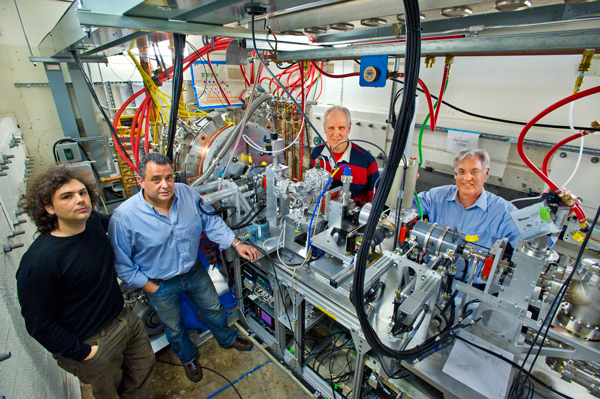
The APEX electron gun and test beamline at the ALS Beam Test Facility. APEX team members include (from left) Daniele Filippetto, Fernando Sannibale, and John Staples of the Accelerator and Fusion Research Division and Russell Wells of the Engineering Division. (Photo by Roy Kaltschmidt, Lawrence Berkeley National Laboratory)
Free-electron laser (FEL) light sources bearing acronyms like FLASH, SACLA, LCLS, and FERMI@Elettra have made a striking entrance on the international stage, but face the challenge of lethargic repetition rates of a hundred or so x-ray pulses per second. With a million or more pulses per second, experiments that now take months or days could be done in minutes or seconds, and new kinds of experiments would become possible.
Of the many needed advances, key are electron guns for FEL accelerators, capable of high brightness and high charge in each of the million electron bunches they produce every second.
“APEX is a room-temperature, radio-frequency cavity that generates a strong VHF field for accelerating electrons in continuous-wave mode,” says Fernando Sannibale of Berkeley Lab’s Accelerator and Fusion Research Division (AFRD), who heads the Advanced Photoinjector Experiment. “Berkeley Lab has proved the underlying principles are sound.”
The first of the project’s three fundamental goals was met a year ago. Installed in the Beam Test Facility of the Advanced Light Source, the VHF gun technology proved its worth.
The second goal is to show that advanced photocathodes can operate under conditions needed for an x-ray FEL like the proposed Next Generation Light Source (NGLS). Laser-stimulated photocathodes produce APEX’s high-quality beam. Operating at high charge and megahertz rep rates needs high quantum efficiency photocathodes, requiring fewer laser photons to produce each electron; most are chemically reactive and depend on extremely good vacuum.
Cesium telluride photocathodes made by the Accelerators and Applied Superconductivity Lab of the Italian National Institute for Nuclear Physics (INFN/LASA) are used at FLASH, but had never been tested under the conditions demanded by APEX.
“Our initial results show that cesium telluride photocathodes can indeed operate with high charge per bunch and at megahertz repetition rates – about 100 times more than at FLASH,” says AFRD’s Daniele Filippetto, an expert on beam measuring techniques. “Running for four days, we generated 40 coulombs of electrons, roughly equivalent to the FLASH injector operating for three months.”
During the run, quantum efficiency declined from about 10 percent to 4 percent. Since photocathodes can be replaced in a short time, and one-percent efficiency can produce the needed charge, cesium telluride photocathodes appear practical for advanced FEL-based light sources. Meanwhile APEX is exploring other photocathode materials.
“At present, APEX with its VHF gun is the only electron source in the world capable of producing high-charge bunches at a megahertz repetition rate,” says Sannibale.
The final milestone is to accelerate the beam to the relativistic energies needed for reliable brightness measures, demonstrating that the brightness of APEX’s high-quality beam meets the needs of NGLS-like machines.
APEX team members are Kenneth Baptiste, Michael Chin, John Corlett, Carl Cork, Stefano De Santis, Lawrence Doolittle, Jennifer Ariel Doyle, Daniele Filippetto, Gregory Harris, Gang Huang, Hanjing Huang, Toby Kramasz, Slawomir Kwiatkoswski, Richard Eric Lellinger, Reginald Llanda, Tianhuam Luo, Vladimir Moroz, William Eric Norum, Howard Padmore, Christos Papadopoulos, Gregory Portmann, Ji Qiang, Fernando Sannibale, John Staples, Massimiliano Vinco, Weishi Wan, Russell Wells, and Max Zolotorev.